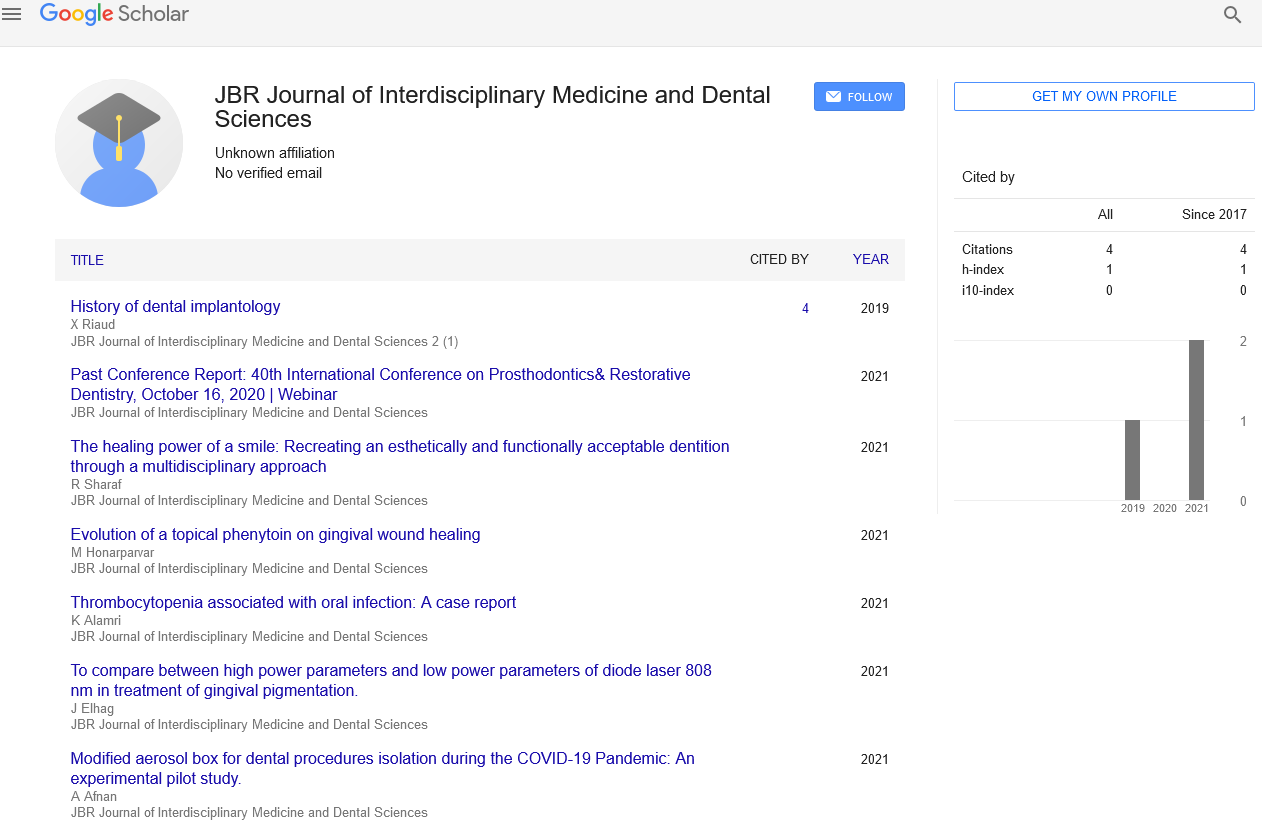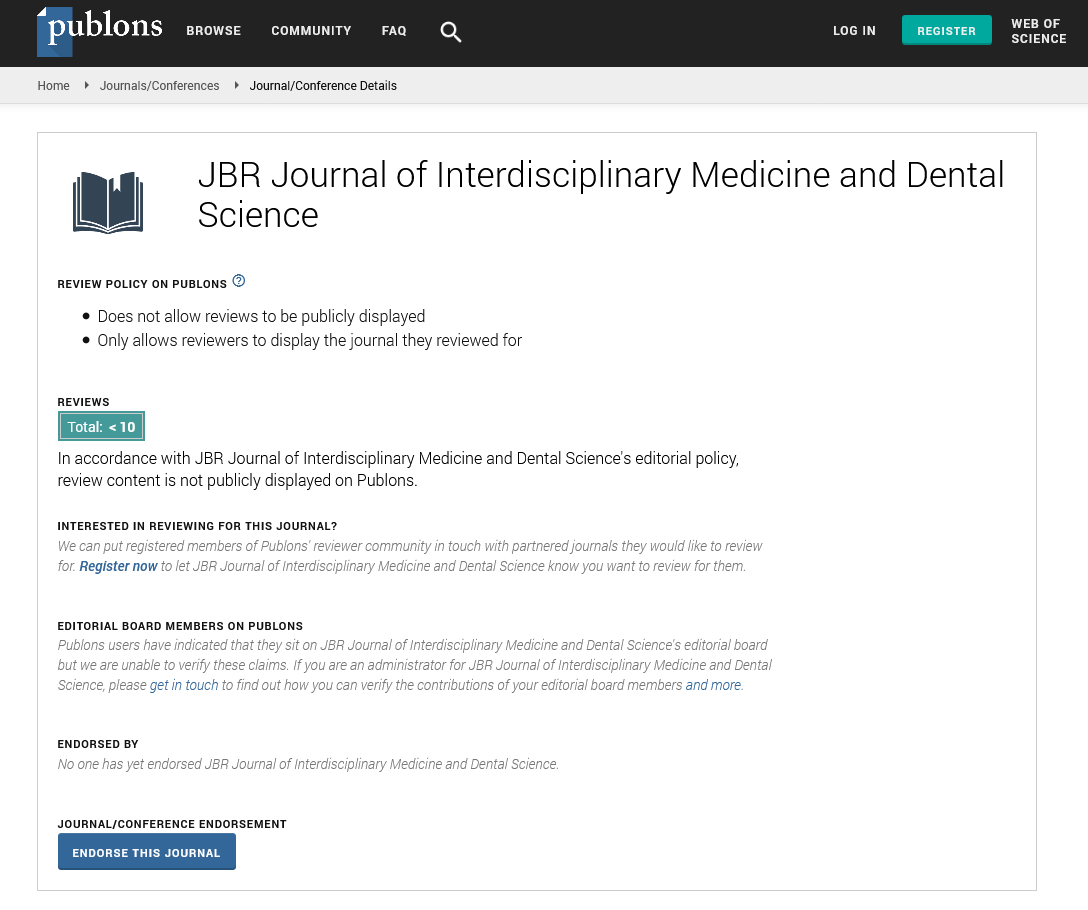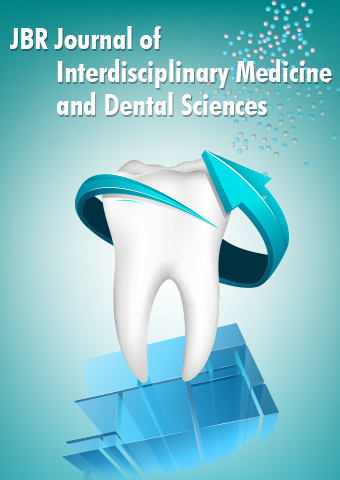Mini Review - JBR Journal of Interdisciplinary Medicine and Dental Sciences (2023) Volume 6, Issue 2
A Short Review on Dental Science: Dental Hygienists and Therapists
Javed Muzab*
Department of Dental, Rifah University Islamabad, Pakistan
Department of Dental, Rifah University Islamabad, Pakistan
E-mail: muzabj@gmail.com
Received: 02-Mar-2023, Manuscript No. JIMDS-23-93508; Editor assigned: 04-Mar-2023, PreQC No. JIMDS-23-93508(PQ); Reviewed: 18-Mar-2023, QC No. JIMDS-23-93508; Revised: 23-Mar-2023, Manuscript No. JIMDS-23-93508(R); Published: 30-Mar-2023, DOI: 10.37532/2376- 032X.2023.6(2).21-22
Abstract
The field of dental sciences encompasses a variety of disciplines that center on the oral health and wellness of individuals. From dental hygiene and patient management to diagnostic imaging and restorative treatments, dental science is continually evolving to provide better care and treatment options. This review article will discuss the different aspects of dental sciences and how they contribute to the overall wellbeing of patients
Keywords
Hygiene ▪ Oral ▪ Dental
Introduction
Oral hygiene refers to the practice of maintaining clean teeth and healthy gums through regular brushing, flossing, and cleaning. Good oral hygiene is essential in preventing tooth decay and gum disease, which can adversely impact overall health. In dental hygiene, dental professionals such as hygienists focus on removing plaque, calculus, and bacteria from a patient’s teeth and gums [1]. Dental hygiene education also teaches patients about preventive dentistry, such as the importance of brushing twice a day and flossing once a day. Patients must also avoid consuming foods and drinks that can cause cavities, such as sugary snacks and carbonated beverages. With proper dental hygiene, individuals can maintain healthy teeth and gums and avoid adverse health outcomes [2].
Patient management
Dental professionals must also manage patients who have dental concerns, such as tooth pain, swelling, or bleeding gums. Communication is essential in patient management [3], as dental professionals must listen to patients’ concerns and communicate effectively to diagnose and treat dental issues correctly. Patient management also involves educating patients about their dental health and preventative measures they can take to avoid future dental problems. Dental professionals must also manage patients’ anxiety and pain during dental procedures, which might involve administering anesthesia or sedation [4].
Diagnostic imaging
Diagnostic imaging in dental sciences plays a critical role in identifying dental problems that are not visible to dental professionals through visual examination only. Dental imaging such as digital x-rays, panoramic radiography, and computed tomography (CT) scans provide a detailed view of the teeth, gums, and jaw, which helps dental professionals identify dental problems accurately [5]. With the help of diagnostic imaging, dental professionals can diagnose dental issues such as cavities, gum disease, impacted teeth, or jawbone tumors. Dental professionals can then develop an appropriate plan of care for the patient, which might include surgical removal of teeth or restorative procedures.
Restorative procedures
Restorative procedures in dental sciences refer to the process of repairing or restoring damaged teeth. Restorative procedures might include dental fillings for cavities [6], root canals for an infected tooth, or dental implants to replace missing teeth. Restorative procedures are essential in alleviating pain, improving the functioning of the mouth [7], and restoring an individual’s confidence in their smile. Restorative procedures are continually evolving, and dental professionals must keep up to date with the latest advancements to provide the best care possible [8].
The World Health Organization (WHO) has proposed a definition of health that includes not only the absence of disease or disability but also a state of complete physical, mental, and social well-being. In order to safeguard health in a way that is not limited solely to the treatment of discomfort in a very literal understanding of this term, the integration of the social aspect into the concept of health implies that the professional activity of the health care professional ought to be open to multidisciplinary interactions.
In addition, the profession of health care requires respect for human rights as part of its code of ethics. Identifying the victims of a large disaster and returning their remains to loved ones for burial rites is a significant ethical and legal obligation. The dental hygienist plays a crucial role in the efficient treatment of dental patients, particularly during the initial stage (prevention) and maintenance (after the intervention of a specialist). However, the hygienist may also assist a forensic odontologist in performing medicolegal investigations. Naturally, the latter is the one who conducts medical-legal verifications and evaluations within his area of technical expertise. In contrast, the dental hygienist does not have independent decision-making authority in the area of medical-legal activities, with the exception of the requirement to submit a report to the authorities in cases where he or she is the first and only health professional to identify a suspected crime. Specifically, non-incidental skin lesions, for example, indentations might comprise the primary key stage of a strategy intended to focus this remarkable injury in time as a piece of proof when its incidental quality is a basic component, particularly in less serious wounds.
In cases of managing violent mistreatment of minors, a paediatrician typically plays the preventative and diagnostic roles. However, due to the fact that the head and neck are the body parts that are most frequently injured in instances of mistreatment, we believe that both the dentist and the dental hygienist should participate. The dentist will be in charge of making the differential diagnosis, which will include other clinical manifestations of internal medicine relevance (such as hemophilia, Von Willebrand disease, and leukemia). The final diagnosis will be based not only on the physical examination but also on the medical history and other factors, such as the minor’s body and psychological development and delayed access to medical care.
Conclusion
In conclusion, dental sciences encompass a variety of disciplines that are essential in maintaining individuals’ oral health and wellbeing [9]. Dental professionals such as hygienists, dentists, and oral surgeons play a critical role in providing care and treatment options for their patients. Good oral hygiene, patient management, diagnostic imaging, and restorative procedures are essential aspects of dental sciences that contribute to the success of providing excellent dental care. With continuous advancements in the field, dental sciences will continue to evolve and improve to provide better care and treatment options for patients [10].
References
- Bromley SM. Smell and taste disorders: a primary care approach. Am Fam Physician 61, 427-438 (2000).
- Iranmanesh B, Khalili M, Amiri R, Zartab H, Aflatoonian M. Oral manifestations of COVID-19 disease: A review article. Dermatol Ther. 34, 14578 (2021).
- Biadsee A, Biadsee A, Kassem F. Olfactory and oral manifestations of covid-19: sex-related symptoms - a potential pathway to early diagnosis. Otolaryngol Head Neck Surg .163,722-728 (2020).
- Grewal E, Sutarjono B, Mohammed I. Angioedema, ACE inhibitor and COVID 19. BMJ Case Rep. 13,237- 888 (2020).
- Xu H, Zhong L, Deng J. High expression of ACE2 receptor of 2019-nCoV on the epithelial cells of oral mucosa. Int J Oral Sci. 12, 8 (2020).
- Mollica V, Rizzo A, Massari F. The pivotal role of TMPRSS2 in coronavirus disease 2019 and prostate cancer. Future Oncol. 16,2029-2033 (2020).
- Montazersaheb S, Hosseiniyan KSM, Hejazi MS. COVID-19 infection: an overview on cytokine storm and related interventions. Virol J. 19, 92 (2020).
- Azzi L, Carcano G, Gianfagna F, Grossi P, Gasperina DD, et al. Saliva is a reliable tool to detect SARS-CoV-2. J Infect. 81, 45-50 (2020).
- Riad A, Kassem I, Stanek J et al. Aphthous stomatitis in COVID-19 patients: Case-series and literature review. Dermatol Ther. 34, 14735 (2021).
- Biadsee A, Kassem F. Olfactory and oral manifestations of covid-19: sex-related symptoms - a potential pathway to early diagnosis. Otolaryngol Head Neck Surg .163, 722-728 (2021).
Indexed at, Google Scholar, Crossref
Indexed at, Google Scholar, Crossref
Indexed at, Google Scholar, Crossref
Indexed at, Google Scholar, Crossref
Indexed at, Google Scholar, Crossref
Indexed at, Google Scholar, Crossref
Indexed at, Google Scholar, Crossref


